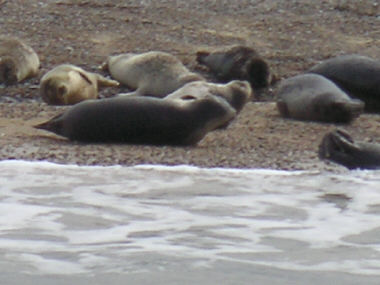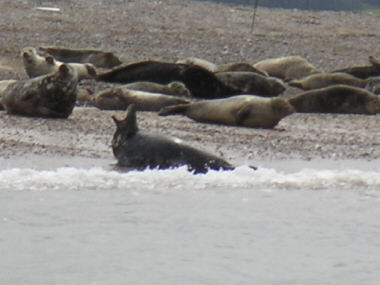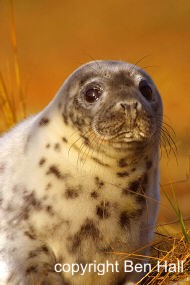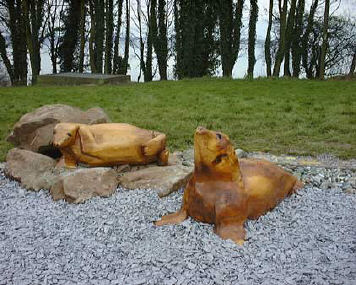ATLANTIC GREY SEAL
(HALICHOERUS GRYPUS)
LOCAL BIODIVERSITY ACTION PLAN
Links
to associated HAPs
None
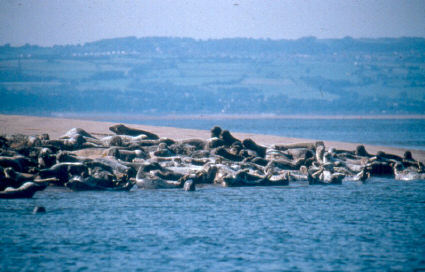 Current
Status
Current
Status
An baseline study
placed the number of grey seal in the UK and Northern Ireland in 1988 at 110,000.
(International Fund for Animal Welfare). The current figure is likely to be
considerably higher.
On Wirral, grey seal
occupy the east side of the West Hoyle sand bank, near to the Hilbre islands.
The Hilbre population do not breed in the Dee. They use the Liverpool Bay area
to haul out, feed and moult. Small numbers of seals venture into the Mersey
Estuary.
It has been generally
accepted that they breed on rocky islands on or around Ramsey Island in West
Wales, though recently this idea has been challenged. It was noted that the
north end of Hilbre was used by a small number of grey seals during the war
years. Occasionally 1 or 2 Grey seals still haul out here. The West Hoyle gathering
is composed entirely of grey seal, though occasional Common seal are also present
in the area. The earliest positive identification of a grey seal in the Hilbre
area is that quoted by Coward (1910): '28 October, 1909, - a young (3 feet 3
inches) Grey Seal was stranded on a bank off Hoylake, captured by fishermen
... secured alive for the Liverpool Museums.' The seals were first known to
use the West Hoyle bank as a haul out during 1928. Craggs and Ellison reviewed
the situation and documented the dramatic increase in numbers using the haul
out between 1951 and 1957. The maximum count for August 2000 was 579.
The grey seal is
on the Biodiversity UK Steering Group Report long list of globally threatened/declining
species. It is currently listed as a protected species under Annex II and Annex
V of the European Community's Habitats Directive and several important sites
for grey seal have been proposed in EC member countries as Special Areas of
Conservation under the Directive. The grey seal is also listed as an Appendix
III species under the Bern Convention.
The Dee Estuary SSSI cites seals as a species of regional interest under reasons
for notification. Further protection for the seal's habitat is given by SPA,
RAMSAR and cSAC designations.
Threats
- Pollution - plastic litter and
toxic chemicals including oil spills
- Disease - eg. Phocine distemper
virus (PDV)
- The threat of large scale culls
due to interaction with fisheries
- Fisheries by-catch
- Poaching of baby seals for fur
- Licensed shooting of seals by
fisheries
- Human disturbance from boats,
jet skis, seal watching trips and aircraft
- Collision with boats and fishing
nets.
How are
we helping to conserve Atlantic Grey Seals in the Cheshire region?
- Wirral Rangers provide information
to schools, colleges, other groups and general public about seals. Information
is conveyed in a variety of forms, for example in Hilbre walks, leaflets,
slide talks about the coast, and in notice boards. Visitors to Hilbre are
encouraged to look at the seals through telescopes.
- The Countryside Council for Wales
carried out a research project to establish the distribution of grey seal
and census of pups in North Wales during 2001. The study is to be repeated
for 2002. Guidance and protocols for monitoring are being developed as part
of the project. Photo identification is also being tried out as a method of
establishing breeding locations and interplay between sites.
- Hilbre Bird Observatory also inform
the public about the seals. They have conducted counts on a daily basis (when
personnel are available) since 1957. Also recorded are weather, disturbance
and comments. Maximum monthly figures are published in their annual report
and some of the data is available in electronic form from the Records Secretary.
The annual report is available for sale direct from the Bird Observatory or
via the internet.
- An MSc research project was carried
out in 2002, on behalf of the Mersey Strategy to investigate the feasibility
of using marine mammals (including grey seals) as indicators of the environmental
health of estuaries.
Objectives,
Targets and Actions
OBJECTIVES
|
LOCAL
TARGETS
|
|
1.
To monitor threats to the seals, ensuring that grey seals ability to use
the Dee and Mersey estuaries does not seriously decline.
2. To increase understanding about the seals among the local population;
particularly people who use the estuary for leisure.
3. To increase understanding between the conservation and fishing communities.
|
1. Maintain and update list
of interested parties including recreation users and fishers and circulate
with up to date information annually.
2. Annually circulate appropriate leaflets and posters including a code
of conduct for wildlife boat trips. |
ACTIONS
REQUIRED
|
- Consider the usefulness
of using buoys to mark a protection zone for the seals by end of 2003.
(WMBC).
- Monitor any commercial activity
that would affect the population. (CCW, Cheshire Wildlife Trust, English
Nature, WMBC, Flint, Dee Estuary Forum, Dee Estuary Conservation Group
(DECG), Mersey Estuary Conservation Group, Mersey Strategy).
- Continue counting seals
daily (whenever personnel are available) and log information at Hilbre
Bird Observatory. Pass information to 'rECOrd', the biological data
base for Cheshire and the Wirral. (Hilbre Bird Observatory).
- Develop guidance and protocols
for monitoring which can be used throughout the Irish Sea. (CCW).
- Encourage research projects
about the seals through liaison with local universities. (WMBC, Hilbre
Bird Observatory, Dee Estuary Strategy/Mersey Strategy).
- Continue providing an information
service to schools, other groups and general visitors to Hilbre. (WMBC
Rangers, Hilbre Bird Observatory).
- Compile a list of all sailing
clubs, flying schools and jet ski clubs who use the Dee and Mersey.
Use contacts in the Dee Recreation Users Group and the Mersey Estuary
Users Forum. Ensure that all these groups are circulated with up to
date information. (WMBC, DRUG, MEUF, Dee Estuary and Mersey Strategies).
- Contact known fishers of
the area.
- Compile appropriate leaflets
and posters including a code of conduct for wildlife boat trips, to
promote the reduction of disturbance to seals. (WMBC)
|
Progress
so far
| 2005
Action Completed |
- Hilbre
Bird Observatory continued to collect figures on seal population in
the Dee Estuary.
|
|
1997-2005
Action Completed
|
- The Countryside Council
for Wales carried out a research project to establish the distribution
of grey seal and census of pups in North Wales during 2001.
- The International Fund for
Animal Welfare have produced a recent leaflet: 'Seals and Seal Watching
in the UK and Republic of Ireland. They sponsored a baseline study in
the UK in 1988.
- Hilbre Bird
Observatory have collected data on the seals in 2004.
- In 2004
Wirral Biodiversity Partnership installed a sculpture of marine mammals
on the River Mersey at Eastham Country Park. It was completed with funding
from the Big Lottery and engaged school children in its design and creation.
The sculpture promotes understanding and appreciation of marine mammals
on our coast.
|
How to find
out more about Atlantic Grey Seals
Hilbre Bird Observatory
- www.hilbrebirdobs.co.uk
International Fund for Animal Welfare - www.ifact.org/Seals
Seal Conservation Society - www.pinnipeds.fsnet.co.uk
This plan is in the Wirral Biodiversity Action Plan which can be viewed at www.wirral.gov.uk/ed/biodiversity/home.htm
How can
you get involved?
If you see a seal
in need of rescue, please phone:
Malcolm Ingham, WMBC Wildlife Officer (0151 648 4371).
Dave Cavanagh, Hilbre Ranger (0151 632 4455),
Dave Holden, WMBC Dog Warden (0151 647 8799)
Contact
details
|
LBAP Chair |
Adam
King , Wirral Ranger Service
Phone: 0151 678 5488 |
References
& Glossary
Anderson S., The
Grey Seal, 1988, no 26 in the Shire Natural History series. Shire Publications
Ltd. ISBN 085263 947 3.
Anderson S., Seals, Whittet Books, London.
Craggs J.D., Hilbre the Cheshire Island, Liverpool University Press, 1982.
Hilbre Bird Observatory Annual Reports.
Westcot Steven, The Distribution of Grey Seals (Halichoerus grypus) and
Census of Pup Production on North Wales. Countryside Council for Wales Science
Report No.499. 2002.


 Current
Status
Current
Status 